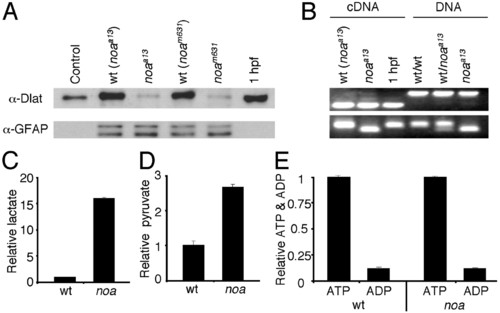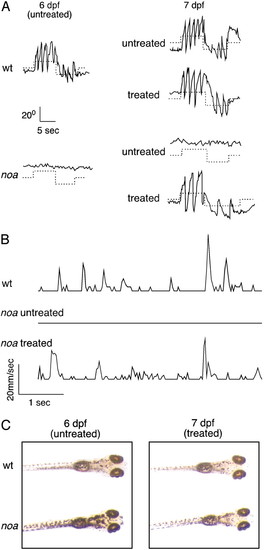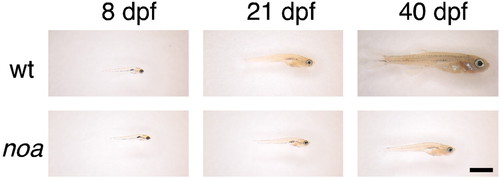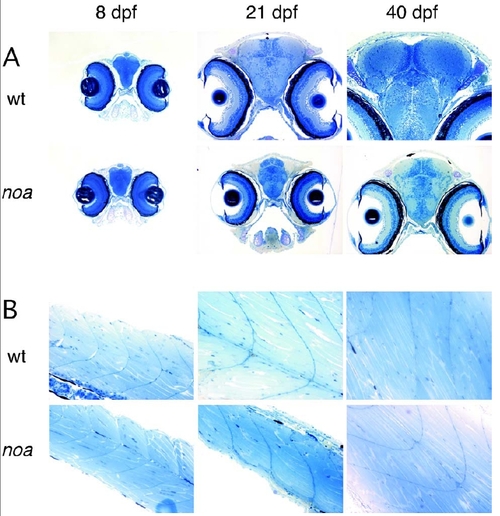- Title
-
A zebrafish model for pyruvate dehydrogenase deficiency: Rescue of neurological dysfunction and embryonic lethality using a ketogenic diet
- Authors
- Taylor, M.R., Hurley, J.B., Van Epps, H.A., and Brockerhoff, S.E.
- Source
- Full text @ Proc. Natl. Acad. Sci. USA
|
Biochemical characterization of noa. (A) Immunoblots of porcine heart PDH (control), wild-type noaa13 siblings [wt (noaa13)], noaa13 mutants (noaa13), wild-type noam631 siblings [wt (noam631)], noam631mutants (noam631), and embryos at 1 hpf using anti-Dlat (Upper) or anti- glial fibrillary acidic protein as a loading control (Lower). (B Upper) RT-PCR (cDNA) and genomic DNA (DNA) PCR using primers that flank a small intron showing mRNA is maternal. (B Lower) PCR using primers that flank the C to T transition in the a13 allele followed by restriction digestion with NlaIII. Quantification of lactate (wt, 165 ± 12 pmol per larvae; noa, 2,655 ± 2 pmol per larvae) (C); pyruvate (wt, 101 ± 7 pmol per larvae; noa, 267 ± 13 pmol per larvae) (D); and ATP and ADP (ATP: wt, 65 ± 1 pmol per larvae; noa, 65 ± 1 pmol per larvae; and ADP: wt, 5.8 ± 0.6 pmol per larvae; noa, 5.9 ± 0.3 pmol per larvae) (E)at 6 dpf are shown. Graphs indicate relative values, and the error bars are the SEM. |
|
Rescue of noa using a ketogenic diet. (A) Representative optokinetic responses of untreated wild-type (wt) and mutant (noa) larvae at 6 dpf (Left), and untreated or FAT wild-type (wt) and mutant (noa) larvae at 7 dpf (Right). (B) Feeding and locomotion behavior of wild-type (wt), untreated mutant, and FAT-mutant larvae at 7 dpf. Movements of larvae are plotted as linear velocity vs. time. The traces illustrate the lunging activity of larvae feeding on paramecia. (C) Pigmentation phenotype of untreated wild-type (wt) and mutant (noa) larvae at 6 dpf (Left), and the same larvae after 24 h in fatty acids (Right). |

ZFIN is incorporating published figure images and captions as part of an ongoing project. Figures from some publications have not yet been curated, or are not available for display because of copyright restrictions. |

ZFIN is incorporating published figure images and captions as part of an ongoing project. Figures from some publications have not yet been curated, or are not available for display because of copyright restrictions. PHENOTYPE:
|
|
Growth retardation in noa. Wild-type (wt) and mutant (noa) larvae were raised on the ketogenic diet, and their growth was assessed at 8, 21, and 40 dpf. Representative pictures of the fish are shown (n = 8 for each group). Note that mutants at 40 dpf are approximately the same size as wild-type fish at 21 dpf. (Bar = 2 mm.) PHENOTYPE:
|
|
Histological analysis of noa. (A) Representative brain cross sections of wild-type (wt) and mutant (noa) larvae at 8, 21, and 40 days postfertilization (dpf) shown at x 100 magnification. (B) Representative muscle sagittal sections of wild-type (wt) and mutant (noa) larvae at 8, 21, and 40 dpf shown at x 200 magnification. Fish were fixed and embedded in epon as described (1). Three-micrometer sections were cut on a Leica RM 2155 microtome and stained with methylene blue/azure blue. |




